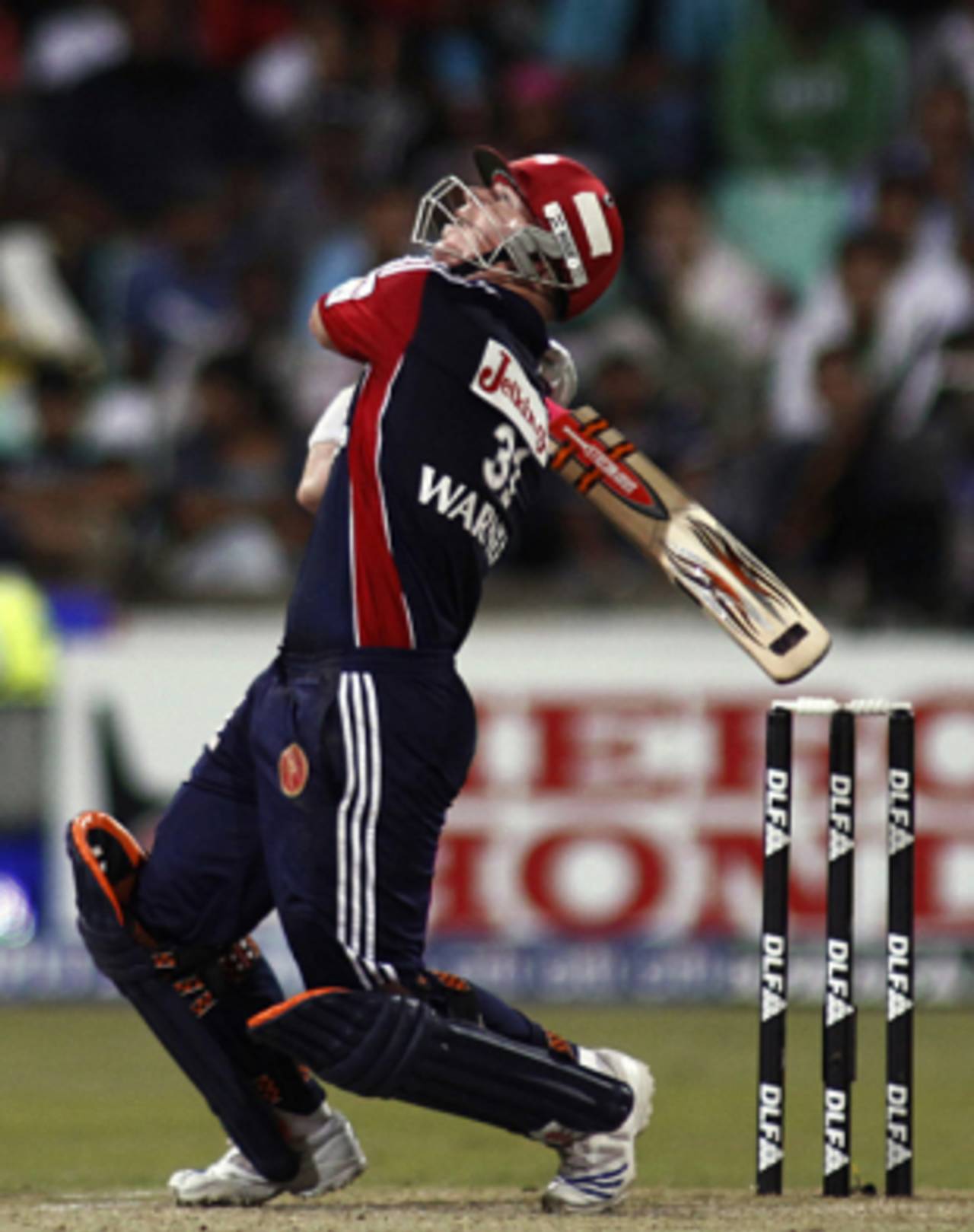The weight on Warner's shoulders
How well can Australia's latest prodigy do? Depends on how well he tackles the doubt, fear and expectation that accompany him when he walks out to bat
Christian Ryan
11-Jun-2009

The only way is up... maybe • Associated Press
When the ball is hurtling at you even the bowler fades to black. There is just the ball and your thoughts. What stops a man from trying to hit every ball for four or six? Doubt and fear: doubt that he is good enough to do it, fear that he will lose his wicket.
Doubt and fear afflict every batsman with a pulse. Doubt, fear and a third companion - expectation - crowd in on David Warner whenever he bats. People expect Warner to slam each ball to the rope or beyond. They expect it the way they expected it of Gilbert Jessop and Viv Richards. What stops a batsman under a strain like that from overcomplicating his task and going slightly mad?
Warner is young. Standing shoulder to shoulder with his team-mates for the singing of the anthem, he looks smaller than his five feet and seven inches. The first ball he ever faced for Australia angled in at his hips, and he paddled it behind square for a single in the manner recommended by a thousand coaching manuals. Was that a peace offering to the traditionalists? The second ball was straighter, and although it went zooming over mid-on's head, it would be wrong to say Warner drove it. He'd pulled it.
Baseball's textbooks, not cricket's, were his preference for the rest of that opening night. Warner's ninth and 10th deliveries disappeared over the leg-side boundary. After 11 balls he was 28 not out. He was 52 after 19. The next morning parents Howard and Lorraine were posing for happy snaps on the couch in Matraville, while the boy David was on a nation's back pages, and some front pages too, beside sepia photographs of Babe Ruth, and my phone was beeping.
"Cameron," announced one text message, "is pull-slogging me in the driveway! Keeps saying he's Warner!" Cameron recently turned six.
By the end of that week reporters old enough to have witnessed a couple of cricketing revolutions were boldly claiming another: "It is conceivable historians, sports scientists and academics will look back on this past week as one of the most significant in cricket's evolution … One senses the game is never going to be quite the same again."
Batting is a perplexing business. That much has stayed constant throughout all of cricket's evolutionary twists. In the weeks that followed, Warner played with the same free swing and, seemingly, the same clear head. But fours and sixes proved hard to come by. That 89 on debut is still his best score. "That's how I play," Warner has said, "and that's how I got here, so if I keep continuing the way I'm going about it, then who knows, I might have a bright future. If not I may have to go to a Plan B."
Plan A and Plan B - attack or defend; it makes it all sound so simple. It isn't really. At some stage planning gets chucked out the window and instinct takes over. Relegated to the state side for a match, Warner was at his stonewalling sternest. He cruised at a mere run a ball, not a boundary per ball. Then the spinner came on. Warner took one step backwards, launched into a harebrained reverse-heave, and was bowled.
At The Oval on Saturday one ball he slugged made the Babe Ruth comparisons ring true. His feet did not move. The back-swing tumbled down smooth and voluminous. His wrists stayed hard and still. His gaze followed the ball out of the old ground and onto the road outside
Now when he bats there is an added complication: he knows that a struggling Australian team's fortunes depend increasingly on his own fours and sixes. At The Oval on Saturday one ball he slugged made the Babe Ruth comparisons ring true. His feet did not move. The back-swing tumbled down smooth and voluminous. His wrists stayed hard and still. His gaze followed the ball out of the old ground and onto the road outside.
Even as he swung, lodged somewhere in Warner's subconscious was yet another thought: that he was playing for his spot. Moments after that giant blow the fielding restrictions ended. Warner had a choice. He could safely bunt ones and twos to far-flung West Indian fieldsmen. Or he could keep shooting for fours and sixes. Warner took the safe option. That didn't feel like a significant turning point in the game's evolution. It felt a lot like the boring middle overs of a 50-over international, the ones Twenty20 cricket is supposed to have eradicated.
Australia, we now know, made too few runs against West Indies. Something similar happened against Sri Lanka on Tuesday. Warner carved his first ball along the ground to gully. No run. He bludgeoned his second ball to the man at cover. Still nothing. And his eyes crinkled a little in mild exasperation.
Two balls. Not a firework to be seen. This wasn't the Warner that fans, peers and sponsors expected. So when the third ball came at him he didn't bother trying to keep it down. He simply hit through the line with those hard, still wrists - and holed out in the deep.
Three loads - doubt, fear and expectation - is a heavy weight in a batsman's head. Whether Warner can cope with it, it is still too soon to say. Maybe he really will revolutionise cricket, a bit like another fair-haired Australian, recently retired. Warner is an R away from Warne, and a couple of zeroes away from obscurity.
Christian Ryan is a writer based in Melbourne. He is the author of Golden Boy: Kim Hughes and the Bad Old Days of Australian Cricket, published in March 2009